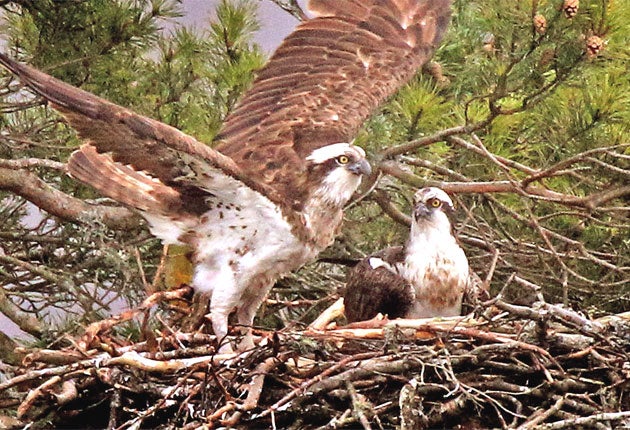Veteran osprey lays her first egg of 2010

Your support helps us to tell the story
From reproductive rights to climate change to Big Tech, The Independent is on the ground when the story is developing. Whether it's investigating the financials of Elon Musk's pro-Trump PAC or producing our latest documentary, 'The A Word', which shines a light on the American women fighting for reproductive rights, we know how important it is to parse out the facts from the messaging.
At such a critical moment in US history, we need reporters on the ground. Your donation allows us to keep sending journalists to speak to both sides of the story.
The Independent is trusted by Americans across the entire political spectrum. And unlike many other quality news outlets, we choose not to lock Americans out of our reporting and analysis with paywalls. We believe quality journalism should be available to everyone, paid for by those who can afford it.
Your support makes all the difference.Britain's oldest breeding female osprey has produced her first egg of the season, wildlife experts confirmed yesterday.
The osprey returned to the Scottish Wildlife Trust's (SWT) Loch of the Lowes wildlife reserve last month for the 20th year in a row, and has been spotted hunching over an egg by wildlife watchers logging on to a webcam positioned close to the nest.
The 25-year-old bird of prey has now produced 56 eggs in her lifetime, and has managed to rear 46 chicks. Most ospreys only live for an average of eight years and produce an estimated 20 eggs in that time, so the female is described by the trust as "a wonder of nature".
Her extensive experience has come in handy in helping her to train up her new, younger mate. According to the trust, the 10-year-old male – who is not the female osprey's usual partner – was "initially a bit confused" about his role as a prospective father.
Male ospreys provide food for the females as they sit on the nest, bring sticks to maintain its condition and protect it against other males. The female has been calling out repeatedly to show her displeasure, in a bid to get him to work harder at his duties.
Emma Rawling, the SWT Perthshire ranger appointed to protect the osprey during the breeding season, said conservationists at the reserve had been "jumping for joy" since they discovered the female had successfully bred again.
"The osprey faced persecution in the early 20th century and was very nearly driven to extinction by 1916," she said. "But our old girl seems determined to do her bit to help repopulate the species. This is the 56th egg she has produced, and so far 46 chicks have successfully fledged the nest over previous breeding seasons."
She said the bonding behaviour between the couple would increase now that an egg had been laid, but warned the relationship might not be all plain sailing.
"If the usual mate of our osprey returns we could witness a battle in the skies, as our resident male will try to chase away the young male and take his place in rearing any young," she said.
"However," she added, "as the days pass by it is becoming more likely that we won't see our resident male. We fear he has perished during the 3,000-mile migration from West Africa."
Every year ospreys migrate from Africa, arriving in the UK in March and April to breed, but little is known about the details of their journey. The SWT is raising money to buy a satellite tag for at least one osprey to track its fortunes once it leaves the reserve. There are estimated to be around 150 osprey pairs breeding in the UK, most of which are found in Scotland.
Join our commenting forum
Join thought-provoking conversations, follow other Independent readers and see their replies
Comments